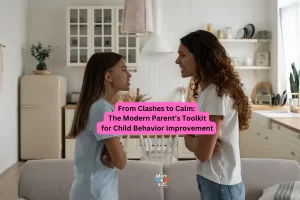
by Michele Borba, Ed.D.
Temper Tantrums are sure to be in the top of parents’ list of “obnoxious, embarrassing kid behaviors.” These are really Oscar-winning performances at their best: ear-piercing screaming, thrashing, and out-of-control behavior. And when your kid uses his routine at school, ballpark or supermarket, it’s just plain humiliating. You should expect your one to three-year-old to try this behavior on you. And it’s equally as common in girls as in boys. Older kids can also resort back to the “tantrum stage” especially if there’s been a recent stress or change in their lives. (We can all name an adult or two who’s yelled, slammed doors and broken something. Right?) But whether your kid continues using outbursts to get his way depends on how you react the first times she tries it. After all, a tantrum is a really a device kids use to get what they want because they’ve learned it works. Once they learn that it succeeds–translation: they get their way-they’re likely to try it again (and again and again). There goes any semblance of “Home Sweet Home.” The truth is there are no redeeming features to this behavior. Tantrums only cause stares and headaches, and teaches kids a bad lesson: “Throw yourself on the floor. Scream and yell. Thrash about and you’ll get your way.” are the steps taming those outbursts my latest book from The Big Book of Parenting Solutions: 101 Answers to Your Everyday Challenges and Wildest Worries,
Parenting Solutions to help Tame Temper Tantrums
Table of Contents
BEFORE the Tantrum
Your best defense is to anticipate a tantrum’s onset before your child is in full meltdown mode.
-
Recognize your child’s natural temperament. Some kids are just more intense and have a tougher time calming down and handling frustrations. If so, give advance warning for an upcoming event; allow transition time from one activity to another; follow an active activity with a calmer one; don’t skip the naps. Avoid situations that might cause temper flare-ups.
-
Recognize your kid’s tantrum signs. Each child has unique stress or “I’m about to loose-it” signs (clenched fists, a certain whimper or whine, waving hands). Once you can identify your child’s “tantrum is approaching signs” you’re in the best place to defuse it or ward it off.
-
Check your expectations. Asking your child to sit too long in a fancy restaurant, shopping cart, or car seat is just asking for trouble. Make sure your expectations for your child are in line with their capabilities.
When a Tantrum is APPROACHING
You see the signs. You have seconds to ward it off. Try the tip that works best for your child:
-
Use calming techniques. Try helping him calm down. Rub his back, hold him gently, rock him or hum or sing song. Get down eye to eye, and talk in a soothing voice tone.
-
Distract and redirect your child’s attention. “Let’s go get your teddy.” “I bet you can’t jump up and touch the sky!” Or try distracting: “Look at that little boy over there.” Your best bet is to try to divert a child’s attention long enough to reroute his energy.
-
Describe feelings. Put your child’s feelings into words: “Oh, you look tired. Are you tired?” “You seem frustrated. Are you frustrated?” Pose a question that your child can answer with a yes or no nod. Labeling his feelings might help wane off a pending explosion (or not).
-
Don’t over control. Be careful about using the “too strict” approach. Spanking, yelling, or trying to be too controlling will backfire.
-
Give a warning. For a verbal child, try giving a warning that lets your child know that if she continues there will be a consequence: “Calm down, Johnny now or we leave.” Sometimes a stern reminder is all it takes. Warnings are effective only for kids at least three years of age. Your child must be able to understand the concepts of a warning and consequence, and have a speaking vocabulary of more than a few phrases.
DURING the Tantrum
Once a tantrum begins, you don’t have much control, but to ensure your child is safe and then let the tantrum take its natural course until it winds down.
-
Stay calm. Shouting, shaking, spanking, getting angry usually makes things worse. Your calmness will help your child get back in control.
-
Ensure safety. Check out the surroundings. If there are sharp edges, glasses or objects that could hurt your child (you, or another child). If so, move him to a “safe zone.”
-
Disengage! Once the tantrum starts don’t give it any attention. No eye contact, no words, do not react. Ignore. Ignore. Ignore. Once your child learns that her outburst “works”-that is she gets her way-she’s likely to try it again (and again and again).
-
Don’t try reasoning. Forget trying to rationalize, coax or bribe with a wailing, flailing kid. The child is out of control and is incapable of responding to logic. It’s like trying to reason with a goldfish. Once in tantrum-mode your child is beyond understanding.
-
Hold only if necessary. With some highly sensitive kids it is only method that calms them. Say reassuringly : “You are angry right now and I am going to hold you until you are calm.”
AFTER the Tantrum subsides
Take a breath and then decide what is your best course to reduce future outcomes and help your child learn healthier ways to express his frustrations.
-
Set a consequence. If your child is older, the behavior is attention getting, you gave a warning and the tantrum continued, you must follow through with the stated consequence. (For example–sending him off to the Thinking Chair to sit (one minute per age of the child until calms). The Calm Down Chair (or Time Out) is effective for children at least three years of age, sometimes for more mature two years olds but never before.
-
Talk about ways to handle frustrations. So particularly with an older child, talk with your older child. Discuss what may have provoked the tantrum as well as ways he can handle it better next time.
-
Reinforce efforts. Do praise your child whenever he tries to verbalize his frustrations or needs instead of resorting to a tantrum: “You asked for help when you were upset. Good for you! Let’s go see what to do.”
-
Pass on your plan. If your kid’s using tantrums with other caregivers–such as spouse, teachers, relatives, babysitters, or day care workers–then establish a plan together for handling the behavior. Consistency is critical in squelching out-of-control behaviors.
-
Teach Feeling Words to Express Frustrations. Teach your child a few feeling words such as angry, mad, sad, tired or frustrated. Once kids have a way to vent their feelings and are given permission to do so, those tantrums often slowly fade.
When to Worry About Tantrums
The American Academy of Pediatrics (1) says you should consult with your pediatrician or mental health professional if the tantrums persist several times a day, have become a pattern whenever your child feels frustrated or angry, are severe, last long, or your child harms herself, others or property during the episode (You can visit their website here.). Seek help also if the tantrums are interfering with a normal, happy parent-child relationship. Illness should also be ruled out. Something else may be triggering the outbursts, and your child needs emotional support and learning to control his anger.
Biography
1) American Academy of Pediatrics: When to worry about tantrums: E.L. Schor, Editor-in-Chief, The Complete and Authoritative Guide for Caring for Your School-Age Child, Ages 5 to 12: New York: Bantam, 2004, p. 232.














I liked your comment above about recognizing your child’s temperament. My oldest daughter was babysitting her cousins for the month of June and did exactly what you talked about in the recognizing point. She planned multiple activities for the kids with time for reading each day. She didn’t allow them to play any video games that were rated above E for Everyone.
I’ve written a children’s picture book that takes a humorous look at how our kids see us as parents. The title is, “My Mean Old Dad”, and was written from my daughter’s perspective.
This is really a great post for me. You were able to give me valuable ideas on how to handle tantrums of my kid. Thanks for sharing.
Aren’t the terrible twos “fun!” I don’t know what is worse – the terrible twos or the thunderous threes… I just posted a fun story/debate on that – I love to hear your thoughts. http://www.maddiesadventures.com/advice-for-parenting/terrible-twos-vs-thunderous-threes